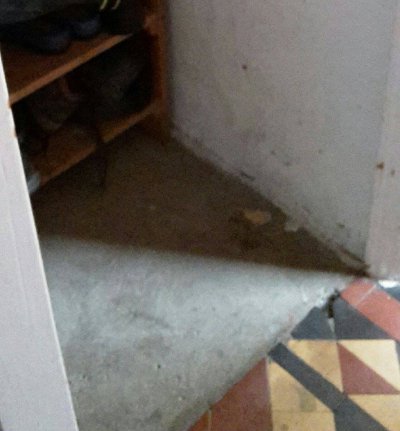Hi,
We have a beautiful Victorian semi from approximately 1880. We are renovating the property ourselves, very slowly as we get the cash. The property has been neglected in the previous years and we are committed to restoring the property to reflect its age and position within the community.
I have two questions relating to the hallway and would really appreciate your expertise.
1)Based on the following do you think it's likely that there would be a blocked off cellar or coal hole?
The property would have been fairly grand for its time however would of had no shortage of outside space. It was one of just a handful of houses in a rural area and a small part of the house we know was used as a shop. The hallway has Minton encaustic tiles (see below). However, the area below the stairs is crudely cemented to the same height as the encaustic tiles. Do you think the area could mark a blocked cellar? The under main-stairs is open and there is no evidence of hinges etc. for a doorway or similar. The main staircase is original. The concrete sounds a little hollow but then we know the encaustic tiles are also on a suspended ceiling. We can't yet look under the lounge boards because there is wood floor fitted which we can't afford to replace if we lift. Outside of the house their is another strip of crude concrete (approx 3/4mtr wide) which runs the entire length of the property, but again no evidence of hinges or doors for a cellar. I understand many coal holes were filled, is it worth investigating. We don't need the space, would just like to restore the whole property sympathetically over time.
2) Would anyone recommend re-laying a Minton encaustic tiles floor.
We are very lucky to have an original encaustic tiled foor in the hallway and porch. Unfortunately though it has not been looked after. We are concerned in particular by a section by a supporting wall where the substrate (?) concrete or lime floor has a large crack and has sunk by approximately 1/2". There is no evidence of cracks in the wall so we think this is a failure in the floor. This leaves a patch around 30x30cm where the tiles are loose and broken. Originally we hoped to give the floor a good clean, sort out the broken area and that would be that. However, we've come to admit that there are multiple cracked tiles, slightly sunken tiles across the hall. We are in this for the longhaul and overall think it needs re-laying with replacement tiles sourced. Is this a realistic prospect for a couple of amateurs? We're not frightened of hard/dirty graft and have experience in many other areas of renovation but have never relayed a floor or sorted out a substrate.
Many thanks for your expertise
We have a beautiful Victorian semi from approximately 1880. We are renovating the property ourselves, very slowly as we get the cash. The property has been neglected in the previous years and we are committed to restoring the property to reflect its age and position within the community.
I have two questions relating to the hallway and would really appreciate your expertise.
1)Based on the following do you think it's likely that there would be a blocked off cellar or coal hole?
The property would have been fairly grand for its time however would of had no shortage of outside space. It was one of just a handful of houses in a rural area and a small part of the house we know was used as a shop. The hallway has Minton encaustic tiles (see below). However, the area below the stairs is crudely cemented to the same height as the encaustic tiles. Do you think the area could mark a blocked cellar? The under main-stairs is open and there is no evidence of hinges etc. for a doorway or similar. The main staircase is original. The concrete sounds a little hollow but then we know the encaustic tiles are also on a suspended ceiling. We can't yet look under the lounge boards because there is wood floor fitted which we can't afford to replace if we lift. Outside of the house their is another strip of crude concrete (approx 3/4mtr wide) which runs the entire length of the property, but again no evidence of hinges or doors for a cellar. I understand many coal holes were filled, is it worth investigating. We don't need the space, would just like to restore the whole property sympathetically over time.
2) Would anyone recommend re-laying a Minton encaustic tiles floor.
We are very lucky to have an original encaustic tiled foor in the hallway and porch. Unfortunately though it has not been looked after. We are concerned in particular by a section by a supporting wall where the substrate (?) concrete or lime floor has a large crack and has sunk by approximately 1/2". There is no evidence of cracks in the wall so we think this is a failure in the floor. This leaves a patch around 30x30cm where the tiles are loose and broken. Originally we hoped to give the floor a good clean, sort out the broken area and that would be that. However, we've come to admit that there are multiple cracked tiles, slightly sunken tiles across the hall. We are in this for the longhaul and overall think it needs re-laying with replacement tiles sourced. Is this a realistic prospect for a couple of amateurs? We're not frightened of hard/dirty graft and have experience in many other areas of renovation but have never relayed a floor or sorted out a substrate.
Many thanks for your expertise


